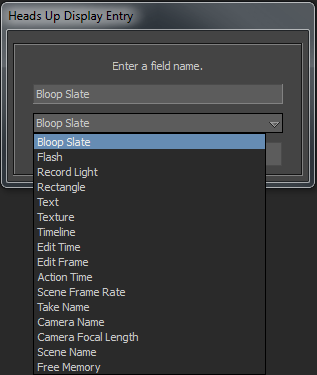There are 16 HUD elements, which you can add to a HUD asset to display additional information (static and dynamic) regarding
a scene in the .

The following table lists the static HUD elements and the information they display in the :
| Static HUD Elements
|
Description
|
| 
|
|
|
|
Flash animation saved in the .swf file format.
|
|
|
Record light
|
|
|
Vector graphic, which you can use as a background or mask for static or dynamic content.
|
|
|
Text that you enter in the property text box. See the Properties of HUD Element section.
|
|
|
Image, image sequence, or a video
|
- Texture HUD element
-
When you import an image, image sequence, or a video (), it appears under the window > folder.
To display a texture from the HUD element in the :
- Click the
 button in the property.
button in the property.
The folder with all the imported textures appear.
- Turn on the checkbox of a texture.
Alternatively, drag a texture from the folder and drop it in the .
- Flash HUD element
-
To display a flash animation from the HUD element in the :
- Click the
 button in the property.
button in the property.
The window appears.
- Select the flash animation (.swf format).
- Click .
- Record Light HUD element
-
The record light let a stage operator know the recording status of a scene. By default, the color of the record light is grey
(

). However, the color changes to indicate the stages in recording.
| Record Light Color
|
What button should you click in Transport Controls to make it appear?
|
What does it indicate?
|
|  green green
|
Record
|
Ready to record
|
|  red red
|
Play
|
Recording is in progress
|
|  (Red with a white, X mark) (Red with a white, X mark)
|
Stop
|
Stopped recording, and MotionBuilder is busy in the post-recording process. After the post-recording process, the record light turns grey (returns to the default
state).
|
The following table lists the dynamic HUD elements and the information they display in the :
| Dynamic HUD Elements
|
Description
|
| 
|
|
|
|
The current time of edit Timeline in frames or Timecode.
|
|
|
The current time of the edit Timeline in frames, by default.
|
|
|
The current time of action Timeline in frames or TimeCode (minimum value is 0 and maximum value is the length of the scene).
|
|
|
The selected frame rate per second (fps). The fps lowers with heavy scenes and raises with light scenes. The highest possible frame rate optimizes to experience smooth playback.
|
|
|
The name of current take. Value can be a number or string.
|
|
|
Name of the camera to which the HUD belongs
|
|
|
Focal length of the camera to which the HUD belongs
|
|
|
Name of the current scene
|
|
|
The free memory in your system. Helps to determine whether you can load heavy scenes or not.
|
You can also add any property of an object (cube, character, stereo camera, and so on) into a HUD element, and refer the value
of the property in the scene.
 Except where otherwise noted, this work is licensed under a Creative Commons Attribution-NonCommercial-ShareAlike 3.0 Unported License
Except where otherwise noted, this work is licensed under a Creative Commons Attribution-NonCommercial-ShareAlike 3.0 Unported License

 button in the Texture property.
button in the Texture property.
 ). However, the color changes to indicate the stages in recording.
). However, the color changes to indicate the stages in recording.  Except where otherwise noted, this work is licensed under a Creative Commons Attribution-NonCommercial-ShareAlike 3.0 Unported License
Except where otherwise noted, this work is licensed under a Creative Commons Attribution-NonCommercial-ShareAlike 3.0 Unported License